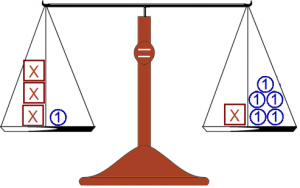Algebra is the branch of mathematics in which letters are used to represent numbers (unknowns) in expressions and equations.
An algebraic expression is a mathematical phrase that contains one or more numbers, one or more letters (variables), and one or more arithmetic operations. The letters stand for numbers that are unknown.
An unknown is a number we do not know, in an equation is the variable to be solved.
Parentheses are used to group parts of an algebraic expression. Example: Twice the sum of a number and 5 , 2(x+5)
An algebraic equation is statement of the equality of two expressions (always include an equal sign). Example: 3x + 4 = 10
An Equation is like a balance scale. Everything must be equal on both sides. The task is to isolate the letter on one side of the equation or the other. Leave a positive variable in the result.
We can add or subtract the same amount on both sides of the equation; we can multiply or divide the same amount on both sides of the equation; and we can swap the expressions on both sides of the equation.
In algebra, we avoid using the multiplication sign (×), so that is not mistaken for the variable X. Multiplication is either indicated by a centered dot ( · ), by placing a number and a letter or by parentheses.
Examples:
Twice a number 2x
5 times a number 5x
A number multiplied by 12 12x
The product of a number and 12 12x
Five times the sum of a number and 2 5(x+2)
The sum of twice a number and three times the number minus 6 (2x+3)(x-6)
A linear equation is an equation that gives a straight line when plotted on a graph.
- Standard Form
Ax + By = C
where x and y are variables and A, B, and C are integers
- Slope-Intercept Form
y = mx + b
where m is the slope of the line and b is its y-intercept.
- Point-Slope Form
y − y1 = m(x − x1)
where m is the slope of the line and (x1, y1) are the coordinates of a given point on the line.
All the forms of a linear equation are equivalent.
If the highest exponent of the variables of an equation is 1, then the given equation is called a first-degree equation. Example: Y = 2X + 5
The graph of an equation of the first degree is a straight line.
A linear equation can be either proportional or non-proportional.
A proportional relationship is a linear equation with slope m that goes through the origin (0,0). The constant b = 0 in the slope-intercept form.
y= mx
Solving One-Step Equations
AL03 Solving Equations (form ax + b = c ) 1
AL05 Solving Equations (form ax + b = c ) 2
AL06 Solving Equations (form ax + b = c ) 3
AL07 Solving Equations (form ax + b = c ) 4
AL14 Solving Equations (form ax + b = c ) 5
AL04 Solving Equations (form ax + b = c ) including negative values
AL16 Solving Equations by Addition and Subtraction 1
AL18 Solving Equations by Addition and Subtraction 2
AL08 Solving Equations with Variables on Both Sides 1
EQ01 Solving Equations with Variables on Both Sides 2
EQ02 Solving Equations with Variables on Both Sides 3
EQ03 Solving Equations with Variables on Both Sides 4
EQ04 Solving Equations with Variables on Both Sides 5
EQ05 Solving Equations with Variables on Both Sides 6
EQ06 Find_Slope
EQ07 Slope 2 point
EQ08 Slope
EQ09 Slope2
EQ10 K_From_Equation
EQ11 K_From_Graph
EQ12 K_From_Table
EQ13 K_Tables
Properties_of_the Equality (Help)




